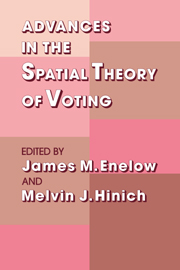Book contents
- Frontmatter
- Contents
- Foreword
- ADVANCES IN THE SPATIAL THEORY OF VOTING
- 1 Introduction
- 2 Multiparty Competition, Entry, and Entry Deterrence in Spatial Models of Elections
- 3 Heresthetic and Rhetoric in the Spatial Model
- 4 Spatial Strategies When Candidates Have Policy Preferences
- 5 A Decade of Experimental Research on Spatial Models of Elections and Committees
- 6 Candidate Uncertainty and Electoral Equilibria
- 7 The Theory of Predictive Mappings
- 8 Multicandidate Spatial Competition
- 9 The Setter Model
- Author Index
- Subject Index
1 - Introduction
Published online by Cambridge University Press: 05 March 2012
- Frontmatter
- Contents
- Foreword
- ADVANCES IN THE SPATIAL THEORY OF VOTING
- 1 Introduction
- 2 Multiparty Competition, Entry, and Entry Deterrence in Spatial Models of Elections
- 3 Heresthetic and Rhetoric in the Spatial Model
- 4 Spatial Strategies When Candidates Have Policy Preferences
- 5 A Decade of Experimental Research on Spatial Models of Elections and Committees
- 6 Candidate Uncertainty and Electoral Equilibria
- 7 The Theory of Predictive Mappings
- 8 Multicandidate Spatial Competition
- 9 The Setter Model
- Author Index
- Subject Index
Summary
The spatial theory of voting continues to be a growth industry in political science. From its modest beginnings in the papers of Hotelling (1929) and Smithies (1941), through the pioneer work of Black (1948, 1958) and Downs (1957) and the early work of Davis and Hinich (1966), spatial voting theory has mushroomed to the point where it can now be broken down into subfields, such as agenda theory and probabilistic election theory. While this growth is a healthy sign, it has made it difficult for the outside observer to obtain a good grasp of recent developments and areas of current research interest. This volume of eight essays by recognized scholars is intended to provide just such an overview of important topics in the spatial theory of voting. These essays are specially written for this book and have never before appeared in print.
It is useful to divide the spatial theory of voting into the spatial theory of committees and the spatial theory of elections. Duncan Black originally analyzed these two social choice problems with a single model, but these two areas of spatial theory are now quite distinct. In the spatial theory of committees, the voters are the key actors, voting over different policy alternatives, each of which is usually represented as a point in a Euclidean space. In contrast, the spatial theory of elections treats the candidates as the key actors, with the voters playing a fixed role. Results in the spatial theory of elections have analogues in the spatial theory of committees.
- Type
- Chapter
- Information
- Advances in the Spatial Theory of Voting , pp. 1 - 11Publisher: Cambridge University PressPrint publication year: 1990
- 6
- Cited by



